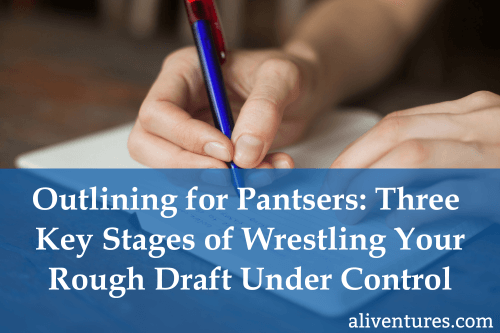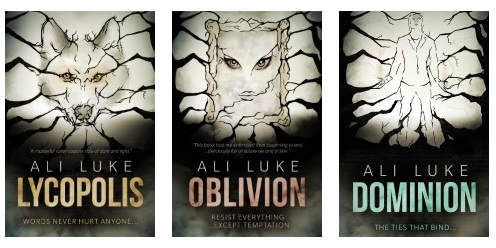Outlining for Pantsers: Three Key Stages of Wrestling Your Rough Draft Under Control

Some writers love to plan out every detail of their plot in advance … but is there such thing as outlining for pantsers?
If you follow writing groups, blogs, or social media accounts online, you’ve probably come across the pantser vs plotter debate: how much should you plan before you start writing your novel?
If you’ve not come across those terms before, here’s what they mean:
- Plotter: someone who likes to outline their novel in detail in advance. That might mean having a chapter-by-chapter plan or writing out scenes on index cards.
- Pantser: someone who writes “by the seat of their pants”. They tend to write in a very exploratory way, letting the story unfold organically.
Both of these approaches are totally valid, and most writers end up falling somewhere between the extremes.
I’m definitely on the “pantser” end of things, and I still like to have some idea about my plot in advance. I’ll often know roughly how it’s all going to end, for instance, or I’ll at least have some major plot points in mind before I start writing.
So how does outlining work when you’re a pantser? In fact, does outlining work when you’re a panster?
Yes! Because…
Outlining doesn’t have to take place before you start your rough draft.
For all the novels I’ve written, I’ve usually outlined in stages while going through the drafting process.
I’ve found it helpful to have a few building blocks in place before starting writing, like:
- Knowing who the characters are, along with their goals and/or motivations. (This could be something as simple as “survival”.)
- Having a sense of at least a few key moments along the way, which might well be key plot points or events that are going to create conflict and raise the tension in the novel.
- Ideally, knowing how it’s all going to end … though sometimes I don’t figure this out until well into the writing process.
If you’re naturally a pantser, don’t force yourself to write a chapter-by-chapter outline. Yes, you’ll read lots of (great and well-meaning) advice telling you that’s what you should do before you start your first draft… but plenty of novelists, me included, have to do a lot of drafting in order to figure the story out.
A quick caveat: this approach does mean you’ll need to be okay with a lot of editing. I’m currently onto Draft 6 of my novel Reaper and I’m so glad the end of the editing is in sight. 😅
So let’s take a look at a few stages of the pantser process, and see how outlining might fit into those.
Stage 1: You’re a Few Chapters in … Now What?
The first roadblock for many pansters comes when they’re three or four chapters into their novel. Their initial idea and getting to know their characters carried them this far … but now they’re not too sure what should happen next.
If that’s where you’re at right now, you might think about:
- How could this get worse for the characters? If in doubt, make someone suffer. This tends to complicate the plot, raises the stakes, and is a good way to push your characters into action.
- What’s your main character’s arc? How are they going to grow or change throughout the story? Think about possible plot events that could feed into this.
- How might two different characters meet or connect in some way? Depending on your story, you might have a bunch of characters who don’t all come into contact with one another. Adding in some more connections between people could deepen the story.
- What’s happening in the bigger world of your story (and how does this impact on your characters)? Whether it’s a major weather event, a distant war, or some kind of social upheaval, it could impinge on your characters and drive the events of your story.
Another good way forward, if you’re feeling stuck, is exploratory writing. Sometimes I outline using “what if…” and then explore possibilities, knowing I’m not committed to them. You could write a whole scene to explore an idea or angle within your story, and see if that’s a direction you want to go in.
Outlining doesn’t need to be a linear list, either. I often outline in note form in a document, but sometimes I’ll turn to a mindmap where I can throw ideas on the page and look for connections or ways to branch off from them.
Stage 2: You’re Changing Your Mind About What’s Already Happened … Now What?
As a pantser, you’ll sometimes get halfway through your story then figure out a better, different way for your plot to go … five chapters ago.
This happens to me more than I’d like to admit, and I’ve also had coaching clients say they’re in a similar situation.
When you’ve decided that you want to shift something earlier in your story, don’t go back and make the change.
Your first draft is not the place to turn back.
(The one exception here is if you need to have a polished first three chapters for an agent, editor, writing group, etc … then you will need to go back and fix things.)
But assuming you don’t have to show your novel to anyone just yet, keep going forward. Leave yourself a note about what’s going to change, so you can address that in the second draft. For instance, you might be starting your novel at a different point in the story, setting a pivotal scene in a totally different location, cutting out a character who wasn’t pulling their weight, adding in a new character … or pretty much any change you can imagine.
Why? Because you might change your mind again, later on. That character you add in may turn out to be unnecessary, or you might figure out an even more atmospheric setting you want to use.
It’s also all too easy to get bogged down in tweaking and perfecting your first three chapters without making any forward progress with your novel.
Stage 3: You’ve Got a (Sort of) Rough Draft … Now What?
When you’ve pantsed your way through a novel, your draft is probably going to be very rough around the edges. My first drafts usually have pieces falling off: whole scenes or chapters missing, random tangents that never went anywhere, characters acting inconsistently, and so on.
All of this is okay at this stage!
Some writers call this Draft 0. Steff Green writes what she calls a “skeleton draft” – a really short first draft that’s like an extended, pantsed, outline. And that can be a good way to see your draft: you’ve now essentially got your outline, with a bunch of complete scenes, and probably a bunch of notes-to-self about what needs to change.
So at this point, I tend to start completely fresh with a blank document, rewriting from page one onwards. I end up changing pretty much every single sentence, along with cutting out big chunks and adding in lots of new bits. (Yes, this does feel inefficient, but over the years I’ve found it’s the most natural process for me … and luckily I’m a fast typer!)
If I’ve got a really scrappy draft, then I’ll sometimes draft the missing scenes first, then restart at page one.
This is often also the stage where I create a timeline: a sort of bare-bones outline that tells me when and where each chapter takes place, which characters are involved, and any major events that occur. (If you’ve got a non-linear narrative, this might be especially helpful.)
Ultimately, writing a novel is messy. If you’re a pantser, you’ll almost certainly feel like you’ve wasted time, worked inefficiently, written way more words than you needed to …
… but that’s all just part of the creative process.
Your process might involve more “mess” (written words that you then chop and change) than someone else’s process. But they, like you, will still be taking time to consider options and refine their ideas. They’re just doing a lot more of that as they outline before drafting.
Neither method is “better” and what’s important is that you develop a way of writing that’s fun, enjoyable, and creatively helpful for you.
If you’d like some support along the way, come and join us in the Writers’ Cafe.
You can chat about all aspects of writing, share your draft material for feedback, get support during tough writing moments, and join our live writing hours to help you sit down and add words to your novel.
About

I’m Ali Luke, and I live in Leeds in the UK with my husband and two children.
Aliventures is where I help you master the art, craft and business of writing.
Start Here
If you're new, welcome! These posts are good ones to start with:
Can You Call Yourself a “Writer” if You’re Not Currently Writing?
The Three Stages of Editing (and Nine Handy Do-it-Yourself Tips)
My Novels

My contemporary fantasy trilogy is available from Amazon. The books follow on from one another, so read Lycopolis first.
You can buy them all from Amazon, or read them FREE in Kindle Unlimited.

0 Comments